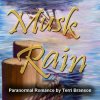
BOOK MARKETING
©2025 Terri Branson • All rights reserved
Marketing Services | Book Reviews | Reader Sites | Social Media | Hashtags | Blogs | Websites | Images | Videos | DIY Marketing
Books are now sold primarily through online bookstores, but marketed through other types of sites. This means that book marketing starts outside of bookstores.
In order to get books noticed in today's glut of retail listings, authors must employ numerous and varied marketing strategies. Long gone are the days of just getting books into online stores and having them found organically. Today there are too many book listings with numerous paid advertisements skewing search results.
Here are some things authors should consider with online book marketing:
• Blogs
• Custom Graphics
• Marketing Services
• Paid Ads (approach with caution)
• Reader Groups
• Social Media Platforms
• Videos (websites, blogs, YouTube)
• Websites (mobile-friendly)
Some authors struggle to understand the nuances of social media posting. Few know how to make custom promotional graphics and videos. Even less know how to create and run their own websites. The fact is that most authors need some level of help with online marketing.
It is easy to get lost in so many options spread across so many portals. There is no rule book for which platform or site works best for what kind of book. Those metrics simply do not exist, because the online landscape is in a constant state of change. People move from site to site, following trends and friends.
Authors need to establish themselves on as many online sites as possible, and then see which ones appear to work best for them. Flexibility is key. If a platform or site seems to lose steam, concentrate efforts elsewhere.
MARKETING SERVICES

Marketing service options are varied and may include any or all of the below:
• Social Media Posting
• Book Reviews
• Blog Articles
• Author Interviews
• Marketing Graphics
• Book Trailer Videos
Many authors rely on paid marketing services to push social media posts to more viewers. Some also need technical assistance creating images and videos. Check out services before you pay them. Make sure marketing services have a large enough "feed" (i.e. amount of followers) to warrant the fees they charge.
It's fine to use multiple services and, in fact, can be a smart strategy because services tend to have different online followers. Just be smart about which services you choose and watch your budget.
Authors pay for the use of marketing service feeds in order to get book information seen by more people at once.
Before using a marketing service, make sure it has a large following that covers the genre of the book or books in question. For example, below the top header graphic on a Facebook page it should show how many followers the site has. If it's in the thousands, then that means it's more than just authors and artists following the service.
The most common book marketing service is one that runs a series of specially-designed posts on designated social media feeds, usually Facebook and Instagram. Those posts consist of a custom image, a paragraph or two about the book, and where to buy it. These posts go out on a set schedule and often repeat in a few weeks.
Some marketing services include a book review option and charge by how many potential reviews an author wants.
There are services that create only book trailer videos. Those video files are sent to the author, who then must post them on websites, social media sites, and YouTube.
Most services create a few marketing graphics as part of the service package. Specialized custom graphics cost more and are usually only offered by graphic artists, who get paid well for their time and expertise.
People have different views on how to pay for online services. As a general rule, most book marketing services use simple PayPal invoices. A few have retail shopping carts, that offer multiple payment options.
Legitimate online services will never ask for a check or any banking information. Keep all personal information behind a "pay wall," so the recipient never sees anything more than your name and email address.
How much should an author spend to promote the release of a book? Although there is no set answer to that question, one good rule to follow is this:
Limit spending to a reasonable expectation of what can be earned in royalties during the first six months of a book's release.
Since there is no way to predict which books will be popular or how strong the book marketplace will be at any given moment, budgeting for book marketing remains more of an art form than a science.
BOOK REVIEWS
Gathering a large number of legitimate book reviews is one of the hardest things to do right now, mainly because readers are scattered across so many sites — from reader groups to social media.
There are many types of book review services. Some only read books and post reviews for a set fee. Others offer more services to authors, such as book marketing and book trailer videos. These include:
• CoffeeTime Romance and More
• N.N. Light's Book Heaven
• Readers' Favorite
Online bookstores that work well with authors and publishers include Barnes & Noble and the ebookstore Smashwords.
Some online bookstores now restrict the kinds of reviews that can be posted on their sites, mainly by banning editorial reviews. This effectively blocks publisher participation. Those sites now rely on review comments, that too often devolve into destructive social media banter.
Why push publishers out of the book review process? — There are many excuses given for these actions, but the bottom line is money. Some online bookstores make more money on click-ads than from actual book sales. Since publishers tend to be more cautious about marketing expenditures, some bookstores and social media sites concentrate on selling click-ads to authors.
It is now up to authors to gather book reviews and then work hard to get them posted on bookstores, blogs, websites, reader sites, and across social media.
READER SITES
Over the last twenty plus years there have been enormous changes in online reader groups. First there were reader email groups, almost all of which are now gone. The most popular without question were powered by now defunct Yahoo Groups. Then came (and went) several online reader platforms. Several years ago book clubs started popping up across social media sites.
The one thing that most reader groups lack is author participation. Current reader platforms that allow authors to participate on their sites include Goodreads and Bookbub.
Several years ago Amazon purchased Goodreads, overhauling its massive website to turn it into an Amazon-centric reviewer site. Reviews posted on Goodreads do migrate onto other sites, so authors should weigh its benefits.
The most popular independent reader site is Bookbub. To sign-up for a free membership, you only need a name and an email. They don't ask for any other information. Bookbub has millions of readers worldwide.
Authors can create profiles on Bookbub using the Bookbub Partners portal, which is also free. Although Bookbub stays in business by selling ads and services to authors, it is free to use. At the very least, all authors should get their names and books listed at Bookbub and encourage readers, friends, and family to follow them out there and to post book reviews.
SOCIAL MEDIA
There are many social media platforms that can be used for book promotions. The most popular are: Bluesky • Facebook • Instagram • Pinterest.
[NOTE: Image specs below are given width by height (WxH) in pixels as standard JPG (written as: ".jpg").]
The newest social media hotspot is Bluesky, which has been growing at a rapid pace. Creating an account at Bluesky is easy. You need an email address, a profile name (pick from what's available), and a unique login password. Then provide a profile picture and a banner image. Here are some tips for Bluesky:
• Text Posts: 300-character limit
• Hashtags: 2-3 maximum recommended
• Profile Picture: 400x400
• Profile Banner: 1500x500
• Posts cannot scheduled
• Posts cannot be edited (delete/re-post instead)
• Landscape Images (16:): 1200x675 or 1600x900
• Portrait Images (4:5): 1200x1500 or 1080x1350
• Square Images (1:1): 1200x1200 or 1080x1080
• Videos: under 1 minute; under 100MB; MP4 or MOV
[NOTE: Links activate on Bluesky, but try to use the shortest ones possible.]
For several years, Facebook has been a marketing must for authors, who are encouraged to establish public "author pages" which are separate from personal profiles. Authors can post text, images, and custom-sized videos. It allows long text posts, but staying under 500 words is recommended. Images work best in landscape 16:9 (1200x675), square 1:1 (1080x1080 or 1200x1200), and portrait 4:5 (1080x1350 or 1200x1500).
Facebook does not allow you to "set" website links in a post, but you can add links to the text. Once a post is shared on Facebook, links activate and become clickable. As a general rule, you should use the shortest links possible.
Instagram has gained in popularity over the years, mainly because it's a visual platform with less social media banter. Authors can use Instagram for all kinds of marketing, but each post starts with an image or a short video.
Share an image or video on Instagram:
1: Upload a photo or video
2: Choose a filter (optional)
3: Write a caption and include # hashtags
4: Click SHARE
There are no "live links" in an Instagram post. You can include a link in a caption, but it will not activate. That means people cannot "click" on it. However, you can always provide a short link for people to write down or copy. When setting up your Instagram account profile be sure to include a blog or website address, which will show live (i.e. clickable). That way people can always click on your profile to find out about your books.
Pinterest can help get books discovered, because the site was built to make posted images easy to find through search engines like Google. To facilitate web searches, do two things: (1) make sure the file name reflects the book in question, and (2) add tags that assist in the generation of search data. For example, the book cover image file for the western romance PRAIRIE FIRE could be named prairiefire1080x1080.jpg with the hashtags: #prairiefire #western #romance #cowboys #oldwest.
HASHTAGS

Hashtags, denoted by the pound symbol (#), are the most critical aspect to social media circulation. Social media sites utilize hashtags differently, so know the preferences and suggestions for each of them. Some encourage using as many as a dozen hashtags, while others restrict them to at most five.
Hashtags are internal platform "search keys" that allow people to find things by topic, such as: #sciencefiction, #Christmasbook, #MarkTwain, #cattoys.
When a site allows just a handful of hashtags, choose them carefully. Another strategy is to use multiple marketing posts that employ different hashtags, while all pointing to the same book, book series, or author.
BLOGS
Although most authors can run their own blogs, some need a little help getting one set up properly. Once working, blog platforms are not difficult to manage.
Blogs have two basic functions: posts and pages. Posts can be "pushed" to social media sites. This means you do a post on the blogsite, and then the platform sends a copy (usually in shortened form) to your linked social media feeds.
The three most popular blogging platforms are:
So far, these three blog platforms still offer free site options. However, free sites do have limitations, usually with smaller storage capacity and less overall functionality. Premium plans offer access to more options and some customer service.
Over the last few years, WordPress has moved all plugins and premium themes (the stuff you really want) behind a business level paywall that starts at $300 per year. While Blogger might appear a little less "fancy" at first glance, it currently offers more tools and flexibility with a free site.
WEBSITES
Three basic things are required in order to create and run a website:
• Domain (internet address)
• Webhost (service that hosts the website)
• Content (webpages)
High-rated webhosts that offer a range of domain and hosting services, from basic to business, include:
• Bluehost
• Host Gator
• IONOS
• Name Cheap
• Web.com
When choosing a webhost, look at more than just the monthly fee. A good webhost plan will include unlimited bandwidth with a large storage capacity plus free domain email support and management. Hosting plans are usually offered in three tiers:
• Basic or personal hosting packages usually only allow one domain website with limited storage, but bandwidth should always be unlimited and custom domain emails should be provided as part of the service.
• Mid-level hosting should support a dozen or more domain websites with unlimited bandwidth, high storage capacity, free custom domain email support, and an online website builder.
• Premium-level hosting, considered the realm of large business, should support dozens of domain websites with high storage capacity, unlimited bandwidth, free custom domain email support, and an online retail site builder.
In the past, managing your own webhosting through a service required quite a bit of technical expertise. These days many hosts offer simpler options, but some people still might need a little help getting started. However, once a domain is registered and tucked properly into the webhosting service, managing a website can be reasonably simple.
If your webhost does not offer some kind of online website builder as part of your hosting service, then consider using a WYSIWYG (what-you-see-is-what-you-get) program to create simple HTML5 websites. One of the best is CoffeeCup, which has been around a long time and remains one of the top choices for visual website builders. It's affordable "Site Designer" software is available for both Windows and Mac. It has a visual interface (or GUI: Graphics User Interface), that helps you build a website using provided themes and widgets (pre-programmed sections).
IMAGES
Platforms, from blogs to social media, use different sizes and shapes of images and photos. Here's a short list in width by height using the open source "jpg" format:
Instagram: 1080x1080 jpg (1:1 aspect ratio)
Blogs/Facebook: 1200x675 jpg (16:9 aspect ratio)
Websites: There are no image size rules on custom websites, except that you should always use the exact size of the image shown. Never set the system to shrink a larger image. This is because the webpage must load the larger image and then take the time to adjust its size. That slows page load-time and eats up digital data.
To show a book cover on a website or blog title page, use some reduction of 6x9 (width by height in inches) or 2:3 aspect ratio. Most book covers are now made for 6x9 trade trim (library). Reductions of 6x9 book covers include:
800x1200 (large)
400x600 (medium)
200x300 (small)
100x150 (thumbnail)
Almost all POD* and ebook vendors now require publishers to upload cover art as 1800x2700 jpgs. On most large retail sites you can view book covers in full size. Authors who do not get these files from their publishers can usually grab them off sites like Amazon and Barnes & Noble. [*POD: print-on-demand]
There are many photo and image editing sites. Most offer limited free options. Mobile devices, both Android and Apple, have apps (some free) that edit photos. The best and most affordable graphics suite software is Corel PaintShop Pro (PSP) for Windows and Mac.
Canva • Fotor • PaintShop Pro • Picsart • PIXLR
VIDEOS

Videos can be used on many types of sites, from social media to blogs to websites and, of course, on YouTube. File requirements vary with each site, and there are also device compatibility issues to consider.
Here are a few guidelines:
Facebook: 16:9 aspect ratio (1280 x 720)
Instagram: 1:1 or 9:16 aspect ratio
Websites: 16:9 aspect ratio (1280 x 720)
WordPress: 16:9 aspect ratio (under 20MB)
YouTube: 16:9 aspect ratio (1920 x 1080 HD)
There are three basic shapes of videos set by aspect ratio: 1:1 (square), 9:16 (portrait), and 16:9 (landscape).
The internet standard video format is MP4 with MP3 or WAV soundtrack. However, some Apple (iOS) devices choke on this type of file. Apple devices create videos in iOS-native MOV with AAC sound, which will not play on other devices.
On a blog or website, you have three choices:
1: Post MP4 and MOV files on separate pages.
2: Post only the MP4 on the blog or website. Then post the HD version on YouTube where everyone, including Apple users, can view/hear it.
3: Post one file at YouTube and link to it.
While it is true that more people carry an iPhone than an Android phone, that gap closes every year. More people now have Android or Kindle tablets than iPads, mainly because of the cost differences. More laptops are Windows or Android than Apple.
People who have lots of electronic devices tend to have a mix of Apple, Android, and Windows. That means authors must find a way to make rich media files, such as videos and audio clips, accessible across platforms.
DIY MARKETING

A lot book marketing can be done in DIY (do it yourself) mode. It all depends on an author's technical skills, familiarity with social media, promotional budget, and available time.
Those with less digital skills may need a little outside help with websites or blogs, social media, graphics, and book trailer videos.
Marketing approaches vary by book categories. Most fiction books (i.e. fantasy, romance, science fiction, western, et al) benefit from wider marketing, such as book trailer videos and custom promotional graphics. Other types of books can be promoted with less "rich media" (graphics, videos, et al) through reader groups and book clubs.
If an author cannot do a website, then they should at least consider a simple blog that doubles as a website. Again, there are free blog options available.
All online book marketing requires graphics, from book covers to posting images and banners. Authors do not need to be experts in making their own graphics. There are lots of online free to affordable photo editor sites, that can help generate good graphics. Most PCs and laptops also have desktop access to simplified graphics programs that will crop and resize images.
The primary thing with book marketing is to create a game plan. Figure out what materials are needed, how much can be budgeted, and set a promotional schedule. ~ Good luck!







